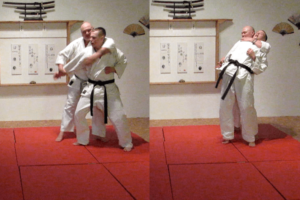
Bunkai means “to break down”, and thus describes the whole process that lies in breaking down and understanding the application of the techniques in a Kata; we simply peel a Kata apart and take a closer look at the application of the individual techniques. The extracted techniques are called Ōyō.
Bunkai 分解; disassembly; dismantling; disaggregating; taking apart; breaking up; analysis; parsing.
Ōyō 応用; Application.
When we analyze the techniques of a Kata, we can see and maybe understand the use of these techniques in relation to self-defense. The easiest way is always to consider a Kata as it is. A block is a block (eg Age-uke) and an attack is an attack (eg Oi-zuki). This is a very simple way to interpret a Kata; this is also called Omote, which means “surface”. What you see is what you get! A kick is a kick and a punch is a punch, nothing else. The counterpart to Omote is Ura, which means “below the surface”, and this is where the real application of the technique can be found.
Some Karate practitioners add an additional level to the already used Omote and Ura. They call the level Honto (or Hontou), which means “truth”, “reality”, “actuality” or “fact”.
The hierarchical levels would be:
Omote 表; surface.
Ura 裏; opposite side; bottom; other side; side hidden from view; undersurface; reverse side.
Honto 本当; truth; reality; actuality; fact.
I believe using the terms Omote and Ura is sufficient, especially considering that Ura and Honto techniques often overlap. Take Gedan-barai as an example:
If I use Gedan-barai to block a front kick, it’s called Omote (What you see is what you get).
Now, if I use Gedan-barai as an attack to the groin or as a takedown in grappling, the question arises: should we label it Ura or Honto? Both applications can harm the opponent and end the fight.
So, which use of Gedan-barai is more accurate to be called the real (Honto) technique? The strike to the groin or the takedown?
Some teachers just like to use many Japanese words in their teachings, and it sounds really good and fancy, but it does not contribute to a better understanding for the student; using fancy words often creates more confusion around the topic than it benefits. Personally, I stick to the word Bunkai.
Thanks for reading.
Gert
Share this article
